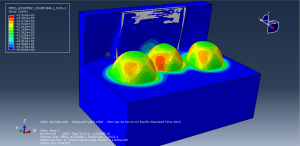In this tutorial, the Simulation sequential CEL explosion in the depth of soil over the RC slab in Abaqus has been investigated. The concrete slab is modeled as three-dimensional solid part, the steel reinforcement is modeled as wire part. The Soil, and TNT are modeled as three-dimensional solid parts. The surrounding is modeled as three-dimensional Eurlerian part. You can see a figure of the assembled parts below

We first consider an ideal representation of underground explosions. Explosions are a common source of seismic waves and span a range of sizes. Small explosions are used for mining, quarrying, road excavating, and other construction applications, as well as in natural resource exploration and active-source seismic lithospheric study. Large explosions include underground nuclear tests, which produce waves strong enough to be observed on the opposite side of the Earth. Natural explosive or implosive sources are rare, but some may occur as a result of metastable mineralogical phase transitions or magmatic processes
The Concrete Damaged Plasticity is selected for the concrete slab under massive blast wave. The model is a continuum, plasticity-based, damage model for concrete. It assumes that the main two failure mechanisms are tensile cracking and compressive crushing of the concrete material. The JWL equation of state is used to model the bombs behaviour under the ground. he Jones-Wilkins-Lee (or JWL) equation of state models the pressure generated by the release of chemical energy in an explosive. This model is implemented in a form referred to as a programmed burn, which means that the reaction and initiation of the explosive is not determined by shock in the material. Instead, the initiation time is determined by a geometric construction using the detonation wave speed and the distance of the material point from the detonation points. The mohr coulomb plastic model is selected to model soil behavior. The elstic-plastic material model also is used for the steel reinforcements
The dynamic explicit step with general contact capabilty is selected for this analysis. The TNT parts are placed in the three locations with delation times in the explosion. Proper boundary conditions are assined to the RC slab and Eulerian domain. To use the Eulerian materials, the uniform or volume fraction method should be used. Using finer mesh has a great effect on the results
After the simulation, all resutls such as stress, strain, damage, failure, wave propagation, blast pressure, and … are available. You can see some figures for teh results below








You can provide CAE ,INP,and English video files of this simulation here. The cost of these files is Twenty-Nine Euros. you can click on the bellow bottom to beginning process
You can purchase the tutorial through a PayPal account, a Visa, or a Master card, just before payment,send me an email to this address: karampourp@gmail.com
 Abaqus tutorials Abaqus tutorials
Abaqus tutorials Abaqus tutorials



